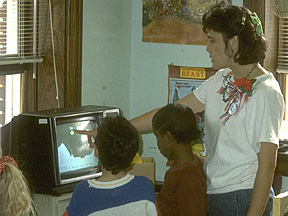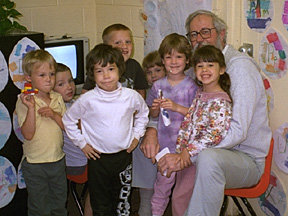

Sign Posts to New Directions from the Pilot Study:
Word and Letter Knowledge
A conservative interpretation of the pilot study results show definite
evidence
of growth due to use of Word Worlds, yet researchers involved in the project
did not believe these results accurately reflected the degree of actual
positive outcomes achieved on one hand, while they also reflected evidence
of lower outcomes than might have been expected on the other.
One hypothesis about why the level of expected outcomes did not occur is
that an overemphasis on instruction in letters as prerequisite to word
knowledge
contributed as a limiting factor. There was no way to tell from the data
whether greater word knowledge and letter knowledge was due to
prerequisite
knowledge of letters or whether the children who knew their letters
constructed
their knowledge as a consequence of their experience with the words. For
this reason, detailed video taped sessions of the complete introductory
and practice process are now being gathered to determine the answer to this
question.
Sign Posts to New Directions from the Pilot Study:
Structure of Implementation
Limiting circumstances which occurred during the pilot study did provide
important information about the relative merits and disadvantages associated
with the different approaches used for implementing and studying
technology
and instructional software in pre-school classroom environments.
In one room, the Word Worlds were implemented in a structured fashion,
with
a research assistant present at all times who provided the children with
one on one instruction on a regular basis. All data collection for this
room also took place in a structured setting. Evidence of growth was present
in the data from this room, but the overall approach did not appear
productive.
One of the limiting factors in this room's results may have been an
overemphasis
on letter instruction over word experience on a day to day basis, and little
opportunity for social interaction between children during learning.
In a second classroom, an unstructured instructional setting was
implemented
by the teachers themselves, with only periodic research assistant support
after the initial introduction of the worlds. This also was not a productive
approach, due to teacher inhibition about their own computer use in the
absence of the research assistant, and reluctance to let the children play
with the computer without direct adult guidance at all times. This occurred
even though the teachers would often let the children do many other equally
challenging activities independently.
Experiences in both of these classrooms demonstrated that, if computers
are to become integrated components of the classroom environment,
extensive
in-service training and flexible support for teachers must be an intricate
part of implementation. These programs should be structured around not
only
helping the teachers become more confident in their own computer use, but
also helping them to become comfortable with a much more relaxed
approach
to their student's independent and frequent use of the technology available
in the classroom, once initial introductions to materials are complete.
The most powerful support for this argument can be found by examining the
success of the approach used in the third room at Headstart. In this room,
a relatively unstructured and relaxed independent learning environment was
created, where the children could use their imagination and curiosity to
freely explore the Word Worlds with a brief period of adult supervision
at first, then relatively independent use alone and with peers later on.
This approach occurred because the research assistant support and
involvement
in this room was flexible. While the research assistant was available much
of the time, the teachers were also encouraged to experiment and implement
the worlds in the research assistant's absence, which the teachers did
successfully
by modeling the relaxed approach to letting the children use the technology
with only minimal adult supervision and intervention.
In order to gain broader success in all rooms, this year we have implemented
more extensive workshop and training activities for the teachers at Headstart.
We now provide an initial in service workshop with the following
agenda:
Let's Talk Computers
1. Staff fears
2. How to set up the computers
3. Getting reacquainted. How to enter and exit.
4. How to work with children. What to do.
5. New ideas and Programs
A second training session is designed to introduce the teachers to how to
begin to make simple microworlds of their own. This session covers the topic
of drawing backgrounds and objects with different colors. A third training
session covers the formation and control of sprite objects. The initial
reactions to the expanded training opportunities have been positive. We
are also providing a low level of research assistant present in all rooms,
where assistants are trained to model a relaxed and unobtrusive approach
to allowing the children to work alone and in groups.
Sign Posts to New Directions from the Pilot Study:
Data Collection
In the third room, there was also a more effectively structured situation
used for data collection. More positive evaluation results during the posttest
situation where obtained on video tape for this room because the data
collection
was done within the same classroom where instruction took place. During
data collection efforts with the other two rooms, strong evidence was
collected
to support that while video tapes recorded in structured and artificial
situations yield videos of higher technical quality, which can be easily
viewed and understood after the fact, the much more optimal performance
of the children is captured in the loosely structured and chaotic environment
of the classroom. While some of the quality of the video tapes made in the
actual classroom situation of the third room often had to be sacrificed,
the quality of the information that remained was more valuable.
It is because of this that the results from the third room during the pilot
study were both more complete and interesting, and the children from the
third room are the focus of this summary of results, even though the
technical
quality of the video records was fairly poor. At the present time, one room
has been selected to be the focus of detailed data collection with a video
camera . In this room it has been possible to set up the camera in an
unobtrusive,
yet effective position to collect all interactions made at the computers
in that room. Most of the data collected in this situation will prove to
be very valuable in the analysis and explanation of how letter and word
knowledge develop during interactions over the course of months.
In addition to collecting data with video camera, information is now recorded
using a simple protocol. The protocol was developed based on experiences
in the pilot study, and provides a way to quickly and efficiently record
the nature, quality and range of a series of interactions which are likely
to take place during the structured situations of the pretest and posttest.
Future Development of Word Worlds:
Apple IIe Computers and Spite Logo
Our selection of hardware and software for this project has been the Apple
Sprite hardware/software system. The low cost, color and graphics in this
system make it is the best one developed so far for young children.
Unfortunately,
the usefulness of Word Worlds developed in Apple Sprite Logo is limited
because the hardware required for this system, sprite boards, is currently
obsolete.
At the present time, some more affluent school districts are moving on to
newer products, such as Logo/Writer, so that their sprite boards are becoming
available in limited quantities at a price within Headstart's reach. This
does provide a temporary opportunity for our work at the Headstart project,
but further software development for this type of situation does have obvious
limits.
Future Development of Word Worlds: Other Systems
We would like further development of Word Worlds to take place in
software
and hardware environments which have more stable and current
availability.
At the present time, this has caused a dilemma for future development
because,
based on recent endeavors by local developers, we believe there is no system
currently available which provides a viable environment for high quality
development of microworlds. The deficits of current environments fall into
two main categories. The first major category of shortcoming is the lack
of a comparable graphics system which allows for the simultaneous and fast
manipulation of multiple objects on the screen, as provided by the co-
processor
on the sprite board in Apple Sprite Logo. The second issue is the lack of
independent addressability of objects within the system, to allow multiple
objects to respond to the same procedural commands as well as on an
individually
addressable basis. Again this capability is provided by the sprite board
in Apple Sprite Logo. Local developers have attempted to use the following
systems for developing Word Worlds, each is followed by brief comments
about the major weaknesses found in each system (Note 1997: Considerable time has passed since this study the original limitations encountered with these systems most likely no longer exist.):
Macromind Director This system does not allow for procedures
which
effect multiple objects, thus making it necessary to provide a separate
program for every action for every object. The number of procedures required
to thus allow for manipulation of many objects is unacceptably large. In
addition, the simulation of simultaneous action is not smooth enough not
to be visible.
HyperCard In the most available version of HyperCard, color is not
possible, and in addition, while objects can be addressed individually or
in unison, the simulation of simultaneous action is very slow and
jumpy.
Think Pascal 3.0 Smooth simulation of simultaneous action and
color
have been achieved in this system, but accessibility and ease of programming
and modifying procedures is unacceptably high at this time.
Object Logo While the developers of Object Logo claim that there
may be facilities available in the newest version, we have not been able
to access enough of the capabilities to made an adequate version of Word
Worlds, but experiments are still underway.
Publication notes:
